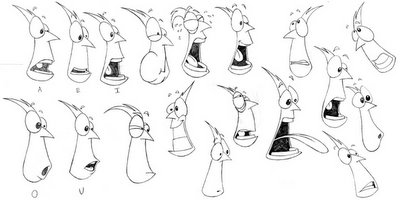In celebration of the one-year aniversary of Stay Cool, I have decided to post a nifty animation test, a little animation history and some much-deserved kudos to two particularly important members of my film crew.
The flavor of the week right now, concerning 3D animation, is what we animators call Squash and Stretch. We have been toiling for the last year (well, my Technical Director has been toiling, I've been annoying her incessantly with petty little requests like 'CAN HIS EYES BUG OUT??!!!") to achieve as much in our film. Why not be cutting-edge for a change, huh?
Click here to see an early animation test of Fritz that exhibits some of his Sqashiness and Stretchiness. I recommend watching it a couple times throuhg, and then use the arrow keys on your keyboard to go frame-by-frame. Watch those legs! (You'll also notice that the model was not even done - WHERE ARE HIS EYES??!!)
A LITTLE ANIMATION HISTORY:
(OR)
WHAT IS SQUASH AND STRETCH AND WHY YOU SHOULD CARE:
Squash and Stretch exists within
The Twelve Principles of Animation that were established between 1928 and 1933 by the animators and artists at the Walt Disney studio. These twelve principles have been the foundation of nearly all animation theory, technique, literature and practice ever since.
The Walt Disney studio completely changed the public perception of animation from novelty to a genuine art form capable of communicating meaning and mood, engaging stories, and subtle shifts in character acting and disposition, all which were formerly exclusive to live action film and theatre.
This animated 'Illusion of Life' was achieved through the intense research and study of real human and animal movement as well as with much experimentation and varied approaches to drawing and film techniques.
Though the Disney artists typically used Squash and Stretch to convey the malleable quality of flesh and to occasionally compensate for what we know in live action film as motion blur, the Warner Bros. artists used it to add exaggeration and extremity their animation that no one had yet seen. Go pick up a classic Looney Tunes DVD and go through just about any of the films frame-by-frame - it will freak you out. (I specifically recommend the Coyote and Roadrunner shorts.)
This wild use of SQ & ST created what we recognize today as 'cartoony' animation. This has recently been the hot commodity in 3d computer animation. (Note the difference in the first
Shrek film and the more current
Madagascar.)
You see, in the past, 3d characters have functioned like virtual puppets - the animators manipulating them in the computer with little virtual armatures. Though this is still very much the case, the animators have been liberated, to a degree. In traditional animation, if the animator wanted the Coyote's neck to stretch from the left side of the screen to the right, and then yank his head off-screen in a blur, the animator just drew it. This, however was not usually the case in 3d animation, due to the rigidity of the 'virtual puppets.' (Note: 'virtual puppets' is not indusrty jargon - just my way of attempting to describe animating a character in the computer without boring you to death.)
With a 3d character like the ones in the earliest Shrek film, the animator can feel a little bit restrained while working, lacking the freedom that s/he once had with his or her pencil. So the goal, as of late, has been to build 3d characters in the computer that contain built-in tools and features that allow the animator to achieve, with their computer-generated characters, this
Squash and Stretch that they could when drawing their characters.
In a sense, the goal is to come full-circle, to return to the 'Illusion of Life' available through the employment of the Twelve Principles, only now, with the computer.
THE DREAM-TEAM:
(OR)
IF YOU'RE NOT SO BRIGHT, ALWAYS MAKE FRIENDS WITH SMART PEOPLE:
All this is to say that
Squash and Stretch in computer animation is a tall order. Pixar achieved a more classic-Disney kind of Squash and Stretch in
The Incredibles, as mentioned above, Dreamworks did it with
Madagascar (super-extreme in this one) and Disney just recently applied beautiful Squash and Stretch in their first CG animation,
Chicken Little. Its wonderful that all of these features are beginning to apply lovely Squash and Stretch animation to their films, (it is certainly enjoyable for the animation-geek demographic) BUT HOW DO BROKE GRAD STUDENTS THAT DON'T HAVE $80 Million BUDGETS AND YEARS OF R&D TO INVEST DO THE SAME THING?
Become friends with
Cara Christeson and
Danny Guinn ...is the answer.
The character is a very flat, graphic design. This became a difficult challenge when attempts were made to translate Fritz into 3d (sculptures, previous CG models etc...). Danny, being a rather prodigious modeler, did a fantastic job and did it at lightning speed.
Go to Danny's Site to see his beautiful 3d interpretations of my 'Fritz Faces' drawings:

Cara has designed a remarkable rig for our main character, Fritz Fizz, with Squash and Stretch GALORE. You can have a lot of fun learning more about the fathomless depth of control that she built into our character by visiting Cara's Fritz Fizz Behind-the-Scenes-Odyssey.

